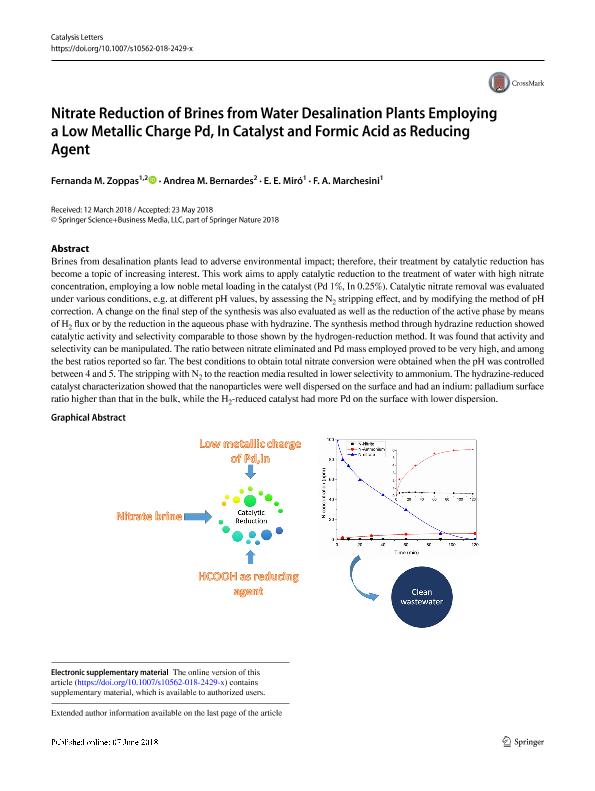Artículo
Nitrate Reduction of Brines from Water Desalination Plants Employing a Low Metallic Charge Pd, In Catalyst and Formic Acid as Reducing Agent
Miranda Zoppas, Fernanda ; Bernardes, Andrea Moura; Miro, Eduardo Ernesto
; Bernardes, Andrea Moura; Miro, Eduardo Ernesto ; Marchesini, Fernanda Albana
; Marchesini, Fernanda Albana
 ; Bernardes, Andrea Moura; Miro, Eduardo Ernesto
; Bernardes, Andrea Moura; Miro, Eduardo Ernesto ; Marchesini, Fernanda Albana
; Marchesini, Fernanda Albana
Fecha de publicación:
07/08/2018
Editorial:
Springer
Revista:
Catalysis Letters
ISSN:
1011-372X
Idioma:
Inglés
Tipo de recurso:
Artículo publicado
Clasificación temática:
Resumen
Abstract: Brines from desalination plants lead to adverse environmental impact; therefore, their treatment by catalytic reduction has become a topic of increasing interest. This work aims to apply catalytic reduction to the treatment of water with high nitrate concentration, employing a low noble metal loading in the catalyst (Pd 1%, In 0.25%). Catalytic nitrate removal was evaluated under various conditions, e.g. at different pH values, by assessing the N2 stripping effect, and by modifying the method of pH correction. A change on the final step of the synthesis was also evaluated as well as the reduction of the active phase by means of H2 flux or by the reduction in the aqueous phase with hydrazine. The synthesis method through hydrazine reduction showed catalytic activity and selectivity comparable to those shown by the hydrogen-reduction method. It was found that activity and selectivity can be manipulated. The ratio between nitrate eliminated and Pd mass employed proved to be very high, and among the best ratios reported so far. The best conditions to obtain total nitrate conversion were obtained when the pH was controlled between 4 and 5. The stripping with N2 to the reaction media resulted in lower selectivity to ammonium. The hydrazine-reduced catalyst characterization showed that the nanoparticles were well dispersed on the surface and had an indium: palladium surface ratio higher than that in the bulk, while the H2-reduced catalyst had more Pd on the surface with lower dispersion.
Archivos asociados
Licencia
Identificadores
Colecciones
Articulos(INCAPE)
Articulos de INST.DE INVEST.EN CATALISIS Y PETROQUIMICA "ING. JOSE MIGUEL PARERA"
Articulos de INST.DE INVEST.EN CATALISIS Y PETROQUIMICA "ING. JOSE MIGUEL PARERA"
Citación
Miranda Zoppas, Fernanda; Bernardes, Andrea Moura; Miro, Eduardo Ernesto; Marchesini, Fernanda Albana; Nitrate Reduction of Brines from Water Desalination Plants Employing a Low Metallic Charge Pd, In Catalyst and Formic Acid as Reducing Agent; Springer; Catalysis Letters; 148; 8; 7-8-2018; 2572-2584
Compartir
Altmétricas



